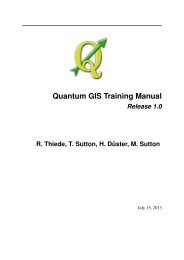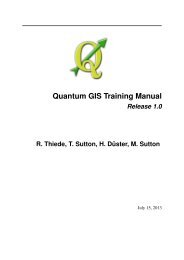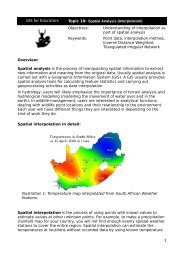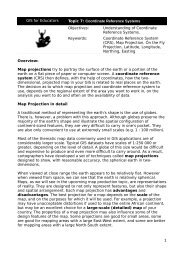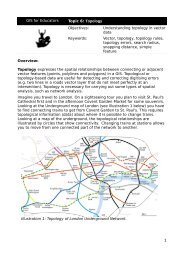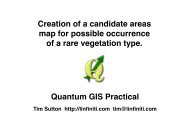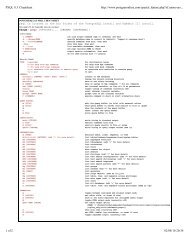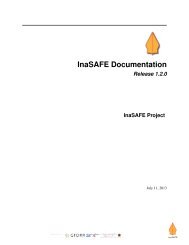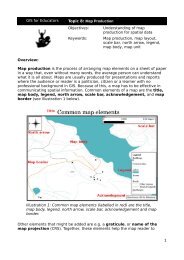PyQGIS Documentation - Linfiniti Geo Blog
PyQGIS Documentation - Linfiniti Geo Blog
PyQGIS Documentation - Linfiniti Geo Blog
Create successful ePaper yourself
Turn your PDF publications into a flip-book with our unique Google optimized e-Paper software.
CHAPTER<br />
FIVE<br />
GEOMETRY HANDLING<br />
Points, linestrings, polygons (and more complex shapes) are commonly referred to as geometries. They are represented<br />
using Qgs<strong>Geo</strong>metry class.<br />
To extract information from geometry there are accessor functions for every vector type. How do accessors work:<br />
asPoint() returns QgsPoint<br />
asPolyline() returns a list of QgsPoint items<br />
asPolygon() returns a list of rings, every ring consists of a list of QgsPoint items. First ring is outer, subsequent<br />
rings are holes.<br />
You can use Qgs<strong>Geo</strong>metry.isMultipart() to find out whether the feature is multipart. For multipart features<br />
there are similar accessor functions: asMultiPoint(), asMultiPolyline(), asMultiPolygon().<br />
There are several options how to create a geometry:<br />
• from coordinates:<br />
gPnt = Qgs<strong>Geo</strong>metry.fromPoint(QgsPoint(1,1))<br />
gLine = Qgs<strong>Geo</strong>metry.fromPolyline( [ QgsPoint(1,1), QgsPoint(2,2) ] )<br />
gPolygon = Qgs<strong>Geo</strong>metry.fromPolygon( [ [ QgsPoint(1,1), QgsPoint(2,2), QgsPoint(2,1) ] ] )<br />
• from well-known text (WKT):<br />
gem = Qgs<strong>Geo</strong>metry.fromWkt("POINT (3 4)")<br />
• from well-known binary (WKB):<br />
g = Qgs<strong>Geo</strong>metry()<br />
g.setWkbAndOwnership(wkb, len(wkb))<br />
21



